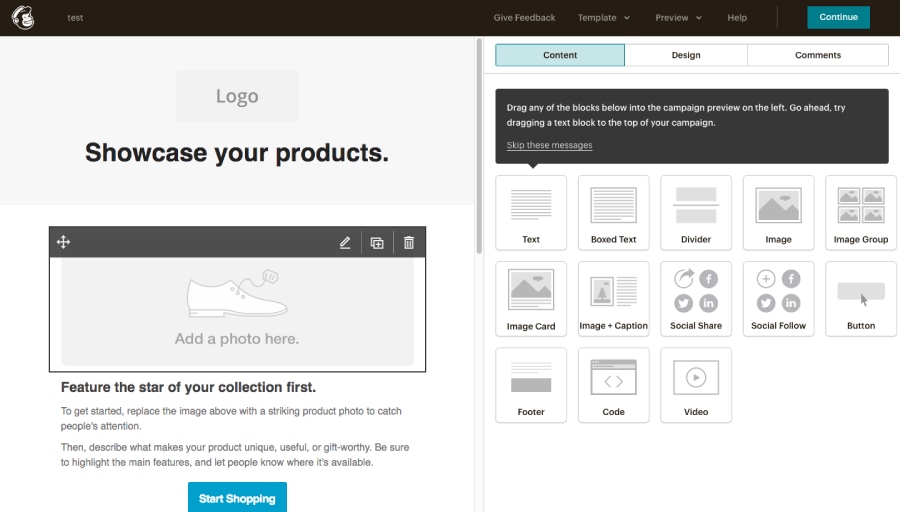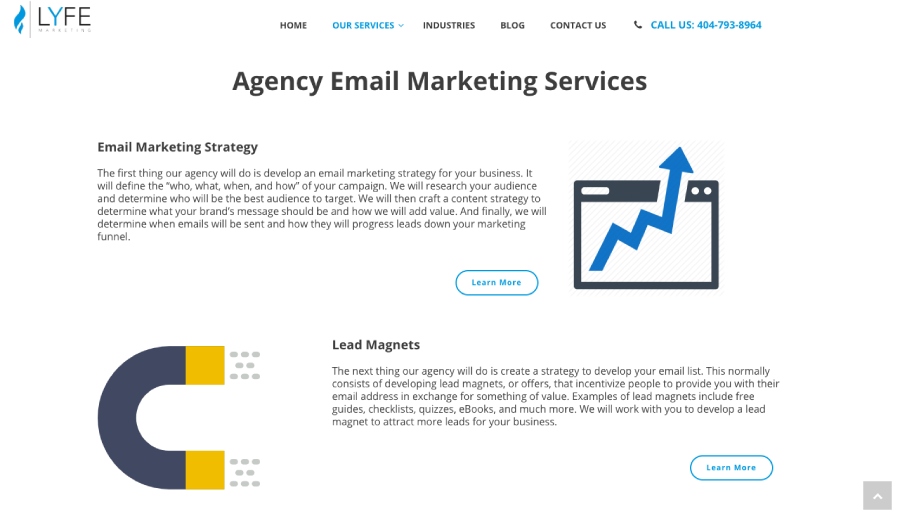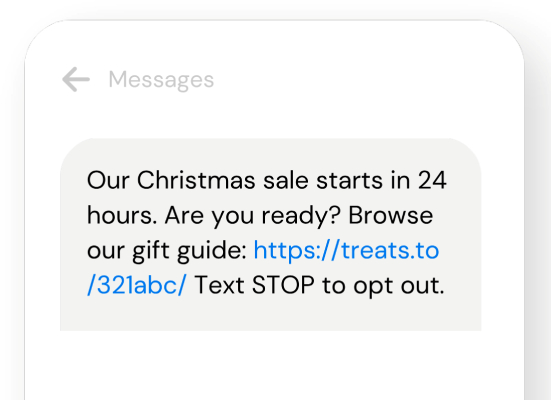Email marketing isn’t just a buzzword or a passing trend. It’s a tried-and-true strategy known to help brands reach more people effectively, even for small businesses with limited resources. Below you’ll find an overview of email marketing for a small business, including some of the nuances of how campaigns work, where they fit in your marketing plan, and what you’ll need to budget for.
Overview (What Is Email Marketing?)
Email marketing is a digital marketing strategy that covers all activities related to using email as a communication tool for promoting your small business. It has the overarching goal of reaching and engaging with a target audience, but also supports customer service, sales, retention, and more.
It’s a long-term strategy that involves managing an email list, planning email marketing campaigns, creating email copy, deployment, and analyzing results. While often thought of as limited to mass email blasts or newsletters, it actually involves so much more. As such, success often hinges on choosing reliable email marketing software to send out targeted, personalized, and relevant email marketing campaigns made easy with automation.
What Is an Email Marketing Campaign?
An email marketing campaign is a focused effort in email marketing. It involves sending one or a series of emails to accomplish a specific business goal. Examples of business goals for email marketing campaigns include promoting a product, building brand presence, nurturing prospect and customer relationships, increasing loyalty and retention, and collecting valuable customer data.
Here are the common characteristics of a good email marketing campaign:
- Focused: Focus on a specific goal, such as promoting a product launch, gathering customer feedback, or re-engaging inactive subscribers. Ensure that all elements of the campaign align with this central goal.
- Strategic and targeted: Consider how to segment your audience, time your email frequency, and position your messaging for the entire campaign.
- Timed right: Campaigns often have a defined time frame or schedule, with a clear start and end date. It can revolve around a promotion (e.g., start an email promotion for a holiday sale a month before the holiday and end a day after the holiday), customer journey (e.g., start a welcome email upon sign-up and end after three unsuccessful attempts to get them to make a purchase), or event.
How Email Marketing Campaigns Are Deployed (3 Ways)
There are three main ways to execute an email marketing strategy: email marketing software, customer relationship management (CRM) software, and professional email marketing services. The type that is best for you will depend on your unique needs, budget, and goals.
Here are the three primary types of email marketing tools:

Mailchimp’s email design interface for opt-in email marketing campaigns (Source: Mailchimp)
Email marketing software gives businesses an easy way to build, execute, and manage email campaigns. These platforms generally include features for contact list management, email design, automation, A/B testing, and user analytics. There are many different platforms available, and many offer free and low-cost plans.
Here’s an overview of four popular email marketing software platforms and who they are best for:
Top email marketing software overall, and best for A/B testing | Ideal for sales lead generation and nurturing | Best (and cheapest) for large contact lists | Great for ecommerce businesses using Shopify |
|
|
|
|
Free up to 500 contacts; paid plans from $13/month | Free up to 2,000 sends/month; paid plans from $18/month | Paid plans from $7.49/month for 1,000 contacts | Paid plans from $12/month for up to 500 contacts |
If you’re just starting to consider adding email marketing to your operation, you don’t have to go out and spend a lot of money. You can test the waters using one of these free email marketing software platforms before stepping up to a paid plan. But if email is working for you, you’ll definitely want to upgrade.

HubSpot CRM’s native email marketing tools (Source: HubSpot)
Customer relationship management (CRM) systems are platforms that give businesses a way to manage contacts and foster connections, including through email marketing tools. CRMs provide an all-in-one lead nurturing solution—so those looking to nurture contacts using email marketing will find it a good solution. The top platforms include HubSpot, Freshsales, and Zoho, with costs from $0 to $50 or more per month.
Transactional emails are the main use case for CRM-based email deployment. These are automated emails that provide users with information related to their transactions with a company. Common transactional emails include order confirmations, shipping notifications, and purchase receipts.
Here are three of the top CRM software providers for opt-in email marketing:
 | ||
|---|---|---|
Free plan with unlimited CRM contacts and up to 2,000 email sends/month | Free CRM plan with two-way email sync | Free CRM and email marketing plans |
CRM Suite Starter (CRM, website, marketing, and customer support Hubs) from $20/month for two users | Paid plans with auto-drip campaigns and email scheduling from $15 per user, per month | Paid CRM plans with email response tracking, 250 sends/day, and 100 templates from $14 per user, per month |
Best advanced CRM with free email marketing | Best CRM for omnichannel marketing | Best CRM with built-in email AI tools |

Agencies cover strategy, implementation, and optimization for email marketing. (Source: Lyfe Marketing)
Professional email marketing services are available to those who want to outsource email marketing to experts. Agencies will strategize, design, manage, and optimize campaigns, yielding a higher return on investment with higher conversion rates. This service is typically available from marketing agencies, and pricing varies by provider and services rendered.
Here are three of the top email marketing management services for those wanting an outsourced solution:
 | ||
|---|---|---|
From $500/month for two campaigns | From $300/month for one campaign plus upfront fee | From $10-$15 to $100 depending on provider |
|
|
|
When choosing which email marketing tool or service to use, consider your budget, time available, and marketing expertise. While it can be appealing to opt for the cheapest option, many find that email marketing is time-consuming and requires a certain degree of marketing knowledge, making outsourced managed services a worthwhile investment.
How to Use Email in Your Overall Marketing Plan
For the most impact, integrate email into other parts of your marketing plan. Not only will this maximize your return on investment (ROI) for email marketing, but it also creates a more seamless customer experience. You can use email to strengthen your efforts for website marketing, SMS (text) marketing, direct mail marketing, and even search engine optimization (SEO) content marketing.
Website Marketing
Nowadays, a business website is seen as one of the primary hubs for engaging with your target audience and showcasing brand identity. This is the reason why website marketing is one of the initial strategies for building brand presence and visibility online, right off the bat.
To incorporate email in your website marketing strategies, use email blasts and newsletters with links to valuable blog content, product pages, or exclusive on-site offers to direct traffic to your website. Another way to use website and email marketing together is to collect email addresses with pop-up forms right from your website to grow your email contact list.
SMS Marketing
SMS marketing is a fast and easy way to get the word out on your brand announcements. Combining SMS and email marketing not only strengthens both campaigns, it is also an opportunity to reinforce your brand identity to your target audience with consistent branding or messaging. Plus, many email marketing platforms now have SMS text marketing add-ons, making it easy for you to manage both strategies from one app.
Use emails for more in-depth content while using SMS for shorter messages, like timely alerts or reminders. Like in the example below, SMS is often used by businesses as a reminder before a sale starts. An email usually should be sent beforehand to announce the sale, along with a link to the sale page. The follow-up SMS reminder creates anticipation and urgency around the original email content.

Sample SMS message to remind customers of an upcoming sale.
(Source: Message Media)
Direct Mail Marketing
Direct mail marketing and email can work hand in hand to create a personalized marketing experience. Although some may think that having both traditional and digital marketing strategies can be overboard, having multiple touch points helps reinforce your brand message—and, it’s an additional opportunity to add a personal touch to your campaigns.
A good synergy of email and direct mail marketing is to collect mailing addresses and preferences, then send targeted direct mail pieces to your target audience to complement a digital marketing effort. For example, send out welcome emails and then double down with a welcome discount voucher sent through direct mail.
Another option is to send a personalized thank-you email to customers who make a purchase, and include an option to receive a handwritten “thank-you” note via direct mail. This adds a personal touch and strengthens the customer relationship. Get more direct mail marketing ideas to partner with your email marketing strategy.
SEO Content Marketing
Email and search engine optimized (SEO) content marketing are a dynamic duo. A content marketing campaign refers to a set of pieces designed for a specific purpose, such as when a new product or service is rolled out. You can then raise the visibility of this content through email by sending out email newsletters or infographics to your contact list.
For instance, if you publish a comprehensive guide on a topic related to your industry, use email marketing to announce its release. Make it even more compelling by providing a teaser of the content. You can even incorporate some sort of social media marketing by including social sharing buttons directly inside the email to encourage readers to share your content on different platforms.
Ready to get started? Read our guide explaining how to create an email marketing plan in five steps, including free templates you can use to build and run your strategy.
How Much Does Email Marketing Cost
From the deployment options above, it’s easy to understand that the cost of email marketing varies widely, from free email software to thousands of dollars per month with managed services. However, the availability of free and low-cost tools makes it accessible for every business size and budget.
There are three primary costs for email marketing: email marketing platforms ($0 to $50 per month), expenses associated with designing email graphics ($5 to $1,000-plus per project), and professional email marketing services (from $300 to $500-plus a month or as low as $5 per project with freelancers). In addition, your costs will vary widely depending on whether you do email marketing in-house or choose to outsource.
Average Cost of Email Marketing for Small Business
Solution | Cost Range | Example Providers |
|---|---|---|
Email Marketing Software | $0-$50/month | Mailchimp, Constant Contact, SendX, HubSpot |
Email & Graphic Design | $5 to up to $1,000 per project | Fiverr, freelancers, agencies |
Managed Services | $300-$500/monthly or $5-$100/project | WebFX, LYFE Marketing, Fiverr |
Here are more details on the primary costs associated with email marketing:
- Email marketing software: Platforms like Mailchimp, Constant Contact, and HubSpot make it easy for anyone to create, deploy, and manage permission-based email marketing. While costs vary by provider, many offer free plans and premium plans starting around $12 to $20 per month.
- Design: Expenses related to graphic design vary depending on whether you are creating your own graphics or outsourcing to a professional. Those with graphic design experience can use free tools like Canva or software like Photoshop for around $20 per month. Those who want to leave it to a pro may hire a freelancer for as little as $5 to $15 with Fiverr or spend up to $1,000 for designs created by an agency.
- Managed services: If you lack the time or expertise, you can outsource email marketing to top digital marketing agencies like WebFX and LYFE Marketing for $300 to $500 per month to start, minus any upfront costs for email design. Alternatively, you can leverage email marketing expertise from freelance professionals from sites like Fiverr on a project-by-project basis for anywhere from $10 to $100 per email campaign.
The average small business will find email marketing to be an affordable marketing channel, with an average expense per month anywhere from $0 to $100 to create their own email campaigns using online tools and platforms. While many small businesses prefer the most affordable option, in some cases, it’s worth considering a managed service for those struggling to reach their marketing goals and get a higher return on investment.
Benefits of Email Marketing for Small Businesses
Email is a tried-and-true marketing strategy, and it’s one of the most effective strategies for nearly all business types year in and year out. Not only is it fairly easy to execute, but it’s also a highly affordable strategy for reaching various goals, from generating and fostering leads, sharing news and content to stay top of mind, and directly marketing products or services.
Here are seven benefits of email marketing for small businesses:
- Affordable: Email marketing is very affordable. Mailchimp, HubSpot, and several other top email marketing platforms offer free starter plans and low-cost plans averaging from about $10 to $50 per month.
- Highly effective: Despite being cheap and easy to do, email marketing is also effective. Nearly 60% of business-to-business (B2B) marketers say email marketing is their most effective marketing channel for generating revenue. Year in and year out, email produces one of the highest returns on investment and the lowest cost-per-lead or sale of any marketing channel.
- Easy: Email marketing software makes it very easy to design emails without any special design expertise, schedule campaigns to send automatically at a specific date and time, conduct A/B test campaigns to improve results, and monitor email interactions and user data.
- Ideal for fostering relationships: Businesses can use email marketing to foster relationships with prospects to drive sales, with existing customers to stay top of mind, with lapsed customers to get re-engagement, and more.
- Great for nurturing leads: Email campaigns are a proven way to drive leads through the sales funnel and stay top of mind. For example, ecommerce stores often use abandoned cart emails to encourage contacts to return and finalize a purchase.
- Perfect for sharing news and content: A good way to share news and published content like blog posts and different types of press releases are through email marketing. It keeps people in the know with what’s going on, from new products and services to corporate news, so it reaches a wider audience and gets more views.
- Ability to market products or services: Email marketing gives businesses a direct way to market products and services to their contact list. Unlike ads that may or may not reach a target audience, email campaigns land in your contacts’ inbox. It’s a good way to share exclusive discounts and promotions as well as info about products and services.
But don’t just take our word for it. Statistics show that email marketing for small businesses continues to be one of the most effective digital marketing strategies:
- Email marketing produces an impressive $36 in return on investment for every dollar spent, more than any other marketing channel.
- Email marketing remains highly relevant today, as 77% of marketers saw an increase in email engagement over the last 12 months.
- Additionally, a report by Statista in 2021 predicts $11 billion in email marketing revenue by the end of 2023.
- OptinMonster (2020) found that 99% of email users check their inbox every day, with some checking 20 times a day.
If you’re still not sure whether email marketing will work for you, read our full list of email marketing statistics for small businesses. Not only will these convince you of the benefits of email marketing for small businesses, but you’ll also find insights to improve the performance of your overall email marketing strategy.
Frequently Asked Questions (FAQs)
Email marketing is highly effective for a small business since it’s cost-efficient and can be personalized to further improve campaign performance. With a successful email marketing campaign, small businesses can reach a high-quality audience, engage with their readers, build customer relationships, and, ultimately, drive conversions. Lastly, email marketing software allows you to track results, making it a valuable tool for small business growth.
To promote your business through email, the most important aspects are branding and a clear call to action (CTA). Start by building a quality email list. Then, create engaging, relevant content (both in the subject line and actual email content) to keep readers interested. Make sure to create these with consistent branding elements such as your brand colors, logo, and messaging. Finally, add in a clear CTA such as a link to your website or social media buttons.
Small businesses use various types of email marketing, depending on the goal. This ranges from promotional emails offering discounts, to loyalty emails, cross-selling, product launches, corporate announcements, and more. Newsletter emails, welcome emails, and transactional emails are also common types of emails that small businesses use to promote their brand.
Bottom Line
Email marketing is one of the most powerful marketing strategies for small businesses. Not only is it cost-effective, but it also allows personalization, automation for streamlining email activities, and even synergy with other marketing strategies such as website or direct mail marketing. Most importantly, email marketing produces positive and measurable results that small businesses can use to fuel their growth.
If you’re ready to get started, we recommend you consider Constant Contact. It’s known for ease of use, great templates, valuable analytics and insights, and easy integration with customer relationship management (CRM) and ecommerce software, alongside email and SMS in your marketing mix. Try it out for free today.